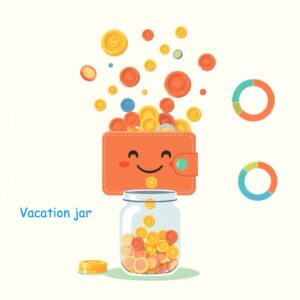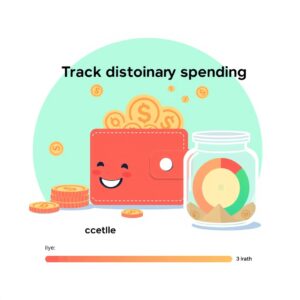Estimated reading time: 10 minutes
Key Takeaways
- Understand the 50/30/20 budgeting rule and its effectiveness.
- Learn how to use the 50/30/20 rule calculator for efficient budgeting.
- Explore top budgeting apps designed around the 50/30/20 framework.
- Adopt simple budget rules to kickstart your financial planning.
- Discover alternative budgeting methods that complement the 50/30/20 rule.
Table of Contents
What is the 50/30/20 Budgeting Rule?
Definition of the 50/30/20 Percentage Budgeting System
The 50 30 20 percentage budgeting system is a straightforward method that divides your after-tax income into three distinct categories:
- 50% for Needs: This category covers essential expenses such as housing, utilities, groceries, insurance, transportation, and minimum debt payments. These are non-negotiable costs necessary for maintaining your lifestyle (SmartAsset, Seacoast Bank, Citizens Bank).
- 30% for Wants: This portion of your budget is reserved for discretionary spending—activities and items that bring joy but are not essential, such as dining out, entertainment, hobbies, travel, and non-essential subscriptions (Seacoast Bank, SmartAsset).
- 20% for Savings/Debt Repayment: This category is designated for building savings, investing for the future, and paying down debts faster than required minimum payments (SmartAsset, Seacoast Bank).
Why It’s Effective
The effectiveness of the 50 30 20 budget lies in its balanced approach, ensuring that essential expenses are met while also allowing room for discretionary spending and prioritizing savings. By clearly defining category limits, it helps prevent overspending on wants and enforces discipline in saving for future goals. This method offers clarity and consistency, crucial elements for both short-term and long-term financial health (Citizens Bank, SmartAsset).
Using a 50 30 20 Rule Calculator
Explanation of the 50 30 20 Rule Calculator
A 50 30 20 rule calculator is an online tool designed to automate the budgeting allocation process for needs, wants, and savings. This tool simplifies financial planning by breaking down after-tax income into essential and strategic categories for efficient money management.
Step-by-Step Guide for Using the Calculator
- Input Monthly After-Tax Income: Begin by entering your after-tax income into the calculator. This amount is what remains after all deductions and taxes have been accounted for (Seacoast Bank, NerdWallet).
- Review Suggested Allocations: The calculator will automatically allocate 50% of your income to needs, 30% to wants, and 20% to savings or debt repayment (NerdWallet, Seacoast Bank, OPERS).
- Compare with Actual Expenses: Input your current expenditures to see how they align with the recommended budget allocations. This step helps identify areas of overspending or potential savings (OPERS, How to Track Discretionary Spending).
Benefits and Popular Tools
Utilizing a 50 30 20 rule calculator ensures accuracy in budgeting, simplifies planning by offering clear visual representations of spending trends, and aids in making the necessary adjustments for achieving financial goals. Popular calculators include those provided by NerdWallet, Seacoast Bank, and the Ohio Public Employees Retirement System, each offering user-friendly interfaces for straightforward usage (NerdWallet, Seacoast Bank, OPERS, The Ultimate Guide to Using a Daily Expense Tracker App).
Top 50 30 20 Budgeting Apps
Overview of 50 30 20 Budgeting Apps
With the rise of digital finance tools, 50 30 20 budgeting apps have become invaluable for keeping track of expenses and maintaining adherence to this budgeting rule in real-time.
Key Features to Look For
- User-Friendly Interfaces: Simplify data entry and daily tracking. The Simplest Budgeting App
- Real-Time Tracking: Allows instant feedback on spending versus targets.
- Bank Synchronization: Automatically updates spending and income. Why a Privacy Budgeting App is Crucial for Secure Personal Finance Management
Examples of Top Apps
- Mint: Known for its automated categorization of expenses and budget alerts.
- YNAB (You Need A Budget): Offers real-time allocation and robust goal-setting features. Pennies App vs YNAB: A Comprehensive Comparison for Effective Budgeting
- Goodbudget: Follows an envelope-style tracking method, ideal for couples sharing expenses.
Tips for Choosing the Right App
Consider whether automatic bank syncing is essential for you. Additionally, prioritize apps that offer educational resources, helping beginners grasp simple budget rules and transition smoothly into more advanced methods as needed.
Simple Budget Rules for Beginners
Introduction for New Budgeters
For beginners, simple budget rules provide a straightforward entry into financial planning. The 50/30/20 rule serves as an excellent starting point due to its balance and clarity, offering a framework that fosters initial success without overwhelming complexity (Citizens Bank, Seacoast Bank).
Practical Tips for New Budgeters
- Track All Expenses for a Month: Gain insight into spending habits.
- Categorize Broadly: Stick with needs, wants, and savings to avoid getting bogged down in specifics.
- Set Realistic Goals and Adjust Monthly: Begin with achievable targets and revise them based on lifestyle changes.
- Account for Small or Irregular Costs: Avoid common pitfalls like underestimating the impact of minor discretionary purchases or sporadic expenses.
Easy Budgeting Methods Beyond 50/30/20
Explanation of Easy Budgeting Methods
Several alternative budgeting methods may better suit different lifestyles and preferences, each presenting its unique strengths and challenges.
Methods to Explore
| Method | How It Works | Pros | Cons |
|---|---|---|---|
| Envelope System | Allocate cash to various spending categories | Effective for avoiding overspending | Not ideal for digital spending |
| Zero-Based Budgeting | Assign each dollar a task, zeroing the budget | Detailed tracking, maximizes efficiency | Requires time-intensive management |
| 80/20 Rule | Save 20%, use the remaining 80% for expenses | Simplicity and flexibility | Less structured, may not fit specific goals |
Table or Comparison
Choosing the right budgeting method largely depends on personal preferences and financial goals. The Envelope System, for instance, is tangible but may not work well with digital payments, while the Zero-Based Budget demands detailed tracking but offers comprehensive oversight.
Advantages of Percentage Budgeting Systems
Why Percentage-Based Approaches Work
- Flexibility: Easily adjust percentages as income or expenses fluctuate (Citizens Bank).
- Clarity: Clear spending limits reduce the risk of overspending.
- Discipline and Planning: Encourages methodical spending habits and strategic saving.
- Success Stories: Many users report significant progress by starting with this structured approach and customizing it over time as they become more financially literate.
Implementing Your Budget: Tips and Best Practices
Practical Steps for Budget Implementation
- Calculate After-Tax Income Accurately: Ensure your budgeting is based on realistic, net numbers.
- Utilize Budgeting Tools: Use 50 30 20 calculators or apps for setup and ongoing management (Seacoast Bank, NerdWallet, OPERS).
- Regular Reviews and Adjustments: Reassess budgets monthly or quarterly to adapt to changing financial landscapes.
- Leverage Reminders and Dashboards: Keep monitoring tools handy for maintaining awareness and control over spending.
Motivation for Staying on Track
Celebrate achievements such as debt repayment, reaching savings milestones, or meeting personal financial targets, which helps maintain motivation and encourages building new goals as old ones are accomplished.
FAQ
How does the 50/30/20 rule work?
The 50/30/20 rule divides your after-tax income into three categories: 50% for needs, 30% for wants, and 20% for savings or debt repayment. This structure helps ensure balanced spending and saving habits.
What are some popular 50/30/20 budgeting apps?
Popular budgeting apps that follow the 50/30/20 rule include Mint, YNAB (You Need A Budget), and Goodbudget. These apps offer features like automated expense tracking, goal setting, and envelope-style budgeting.
Can I adjust the percentages in the 50/30/20 rule?
Yes, the percentages are flexible. You can adjust them based on your financial goals and personal circumstances. For example, you might allocate more to savings or debt repayment if you have specific financial targets.
What if my expenses don’t fit neatly into the 50/30/20 categories?
If your expenses don’t align perfectly, consider combining minor expenses into broader categories or adjusting the percentages to better suit your financial situation. The key is to maintain a balanced approach.
How often should I review and adjust my budget?
It’s recommended to review your budget monthly or quarterly. Regular reviews help you stay on track, make necessary adjustments based on changes in income or expenses, and ensure that your financial goals are being met.
Conclusion
In conclusion, percentage-based budgeting systems, especially when aided by tools like the 50 30 20 rule calculator and budgeting apps, can profoundly enhance your financial management capabilities. Starting with simple budget rules for beginners allows for a smooth transition into more sophisticated budgeting techniques. By adhering to these practices and consistently refining your approach, you promote sustainable financial health, leading to long-term success. Explore these tools and methods to craft a personalized budgeting strategy that aligns with your unique financial aspirations and enjoy the peace of mind that comes with effective money management (NerdWallet, Citizens Bank, Seacoast Bank).




